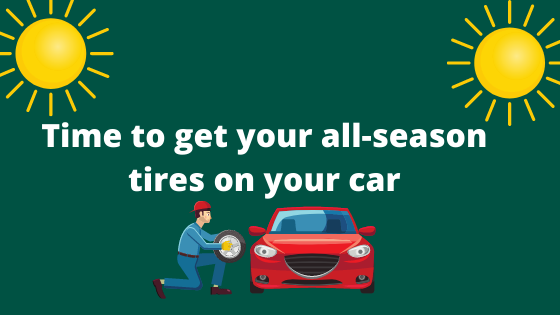Not having sufficient tread depth on your car tires will immediately put you in danger as you drive. You therefore always need to check the tread depth on a regular basis. If you alternate between all-season tires and winter tires, then this is a great time to do an assessment of the condition of both tires. If the all-season tires are not brand new, the position of the tires should be rotated compared to the position they had last they were used. By doing this you even out the wear between the front and rear axle, that differ. If you then also have an electric or hybrid the wear will be higher, and you will need to check the tread depth more often and most certainly rotate the tires more often.
If you notice that you have insufficient tread depth you should visit. your tire shop and purchase a new set of all-season tires of the same dimension. You should always try to aim for premium tires as they will be safer, more environmentally friendly, consume less fuel and last longer. They will probably also be cheaper over its lifetime, due to the lower fuel consumption and the less frequent need of replacement.
The closer you get to the threshold depth of 5/32 inches the more frequently you need to check the tread depth. It is often recommended to do a visual inspection of the tires every time you stop for fuel. You should preferably then also check the tire pressure to make sure that you have good tire pressure. The tread depth you can check then on a monthly basis and more often when needed. You check the tread depth with a coin, where you can have a mark on it where it has the 5/32-inch mark or then you have a tread gauge to measure it. Most tires nowadays will have an indicator in the tread which makes it possible to read based on the wear, which level you are at. It will wear of the numbers so the highest number you can read is the current tread depth. Some will though indicate it in mm and not inches and in that case, you should not go below 4mm.
When you gradually lose tread depth, key properties such as grip on all surfaces will decrease, so the car will skid more, and you might lose grip when cornering. Your braking distance will also increase making it more difficult to avoid accidents. When it then comes to both slush and aquaplaning, the risk for it happening will increase as you have less volume within the channels in the tread to move water to the sides and to store it, once you drive. If you aren’t able to remove all the water, the tires will plane on top of the layer or slush or water and you will lose control over your vehicle. To avoid this, you need to adjust your speed and upgrade to new tires.
For more information regarding new all-season tires, visit: https://www.nokiantires.com
